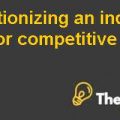
Cradle-to-Cradle Design at Herman Miller: Moving Towards Environmental Sustainability
Section 1
Problem Statement
Herman Miller (HM) was using PVC technology for their arm pads. It was quite cheap and had long term durability but its production was extremely dangerous for the environment and Herman Miller was intending to adopt C2C design specifically for their product so-called, Mirra Chair. They had to replace it with Thermoplastic Urethane (TPU), which was an alternative for PVC but the cost of TPU was higher than PVC and it was uncertain with the consistent quality of arm-pad with TPU. Should Herman Miller replace its arm-pad technology with TPU which is environmental friendly or it should keep using PVC?
Position Statement
It is suggested to move with arm-pads having TPU for the environment because it is a culture of Herman Miller to implement ‘Design for Environment’ strategy. TPU is comparatively a safe technology with the same durability as PVC but it is expensive than PVC. Alternatively PVC is a dangerous material, which can be harmful for human health and environment as well.
Section 2
Polyvinyl Chloride (PVC) was an industry standard for different parts of the furniture including in the manufacturing of arm-pads. Arm-pads contributed almost 10 percent of the total production cost per unit. Though PVC was inexpensive and had all the qualities that were needed with such as durability but it had also anticipated as ‘red’ material. Red material contained all the toxins, which could be dangerous for human health and environment. Herman Miller should move towards phasing-out PVC and implement TPU efficiently with as low cost as possible. Herman Miller was one of the four leading furniture supplier and other competitors had followed their footsteps with respect to environmental leadership. Though TPU will ultimately lead Herman Miller to increase its production cost up to 30 percent per unit but since it is the value of HM to sustain environmental friendly products therefore; they should focus on it more. HM was focusing on eco-effectiveness rather than eco-efficiency. Eco-effectiveness did not generate waste or deplete natural resources and it could not be just recycled but ‘up cycled’. There were basically four elements for implementing C2C protocols, which could be ultimately resulting in eco-effectiveness. The most dangerous element of PVC was it being a ‘red’ chemical containing product. It was the most harmful chemical group among the others, which was critical for environment and human health. Therefore, it was very necessary to eliminate PVC from the furniture in order to make the product able to recycle and disassemble. Mirra Chair will have the ability to get recycled and disassembled. In addition, it will not be containing ‘red’ chemicals which will be environmental friendly.
Therefore, it is recommended for Herman Miller to replace PVC technology with TPU to eliminate health related risks from the environment. Though it will increase the production cost but due to PVC’s high risk factor, it will result in building and sustaining the company’s image towards environmental sustainability. As discussed before, PVC resulted in releasing of toxin materials into the environment that become useless waste at the end. Alternatively, TPU will be able to get recycled at the end of its use.
Section 3
In the final section you will be expected to provide a specific action plan including an accounting of potential risks. This is the key case skill as demonstrated by a written case. The action plan steps should be specific and realistic for the given case scenario. Any potential risks should also be acknowledged and incorporated into your overall plan of action.
Action Plan
Initially, Herman Miller will have to implement the five W’s of change in order to analyze the need for change.
The Five W’s of Change
1. The Why of Change: Initially, Herman Miller will have to find out the reason behind the change. Since, PVC is highly risk and harmful for the environment therefore; it is necessary to implement TPU instead of PVC. TPU is eco-friendly and can be recycled and disassembled at the end of its use. Furthermore, it does not contain any harmful components, which can be dangerous for human health and environment.
2. The What of Change: The usage of arm-pads with TPU will result in providing safety to the human health and environment. Since, the vision of the company is to move towards environmental sustainability that is why it is essential for the company’s brand image. Definitely it is the requirement of an environment to keep it eco-friendly and HM will have to do it through implementation of TPU.
The Who of Change: There are some important employees, whom have to be involved in the process of change. It is necessary to keep them involved and motivated throughout the change process. In this case, HM will have to involve mostly the supply chain and engineering department because they will be the key persons who will be involved. Engineers will be testing TPU with different scenarios to find out its results and supply chain department will be reaching.............................
This is just a sample partial case solution. Please place the order on the website to order your own originally done case solution.
Herman Miller, office furniture supplier, decided to implement the Cradle to Cradle (C2C) design protocol when designing their average office chair, Mirra. C2C protocol had many environmentally friendly product design guidelines created by architect William McDonough and chemist Michael Braungart. The essence of this protocol is to eliminate waste and potentially hazardous materials through product development, so that, at the end of its useful life, the raw material can be submitted in any technical or biological cycle and used for the same or other purposes. Thus, the materials were left in a closed loop, eliminating the need to dump toxic and other forms of disposal, such as incineration. The case describes the C2C protocol information on how Herman Miller C2C is implemented in the design of the chair Mirra, and the impact of a new protocol on their internal processes: the development of solutions, manufacturing, and supply chain management. The immediate point of decision in the case is whether the company should replace the polyvinyl chloride (PVC) material in the hands of the Department of Peace pads. PVC was very toxic material for the manufacture and disposal, and thus violated the C2C protocol. However, it was the standard material for hand pads and many other items in the office furniture industry, as it was durable, scratch-resistant and inexpensive. To switch to a thermoplastic urethane (TPU), a more environmentally friendly material, hand Mirra Chair site requires at least the modification of production tools, or perhaps a completely new tool. In addition, the cost of TPU was higher than PVC. There was also uncertainty about how the consistent quality of the site will be hand with TPU. "Hide
Deishin by Lee, Lionel Bony Source: HBS Premier Case Collection 21 pages. Publication Date: May 30, 2007. Prod. #: 607003-PDF-ENG












